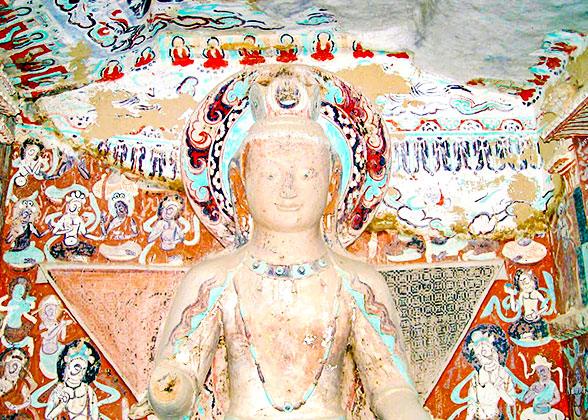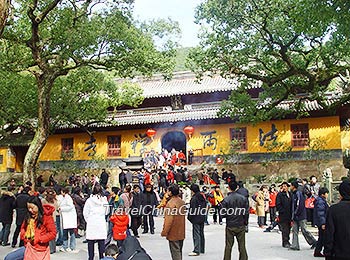History
 |
| White Horse Temple, Luoyang |
Buddhism is the most important religion in China. It is generally believed that it was spread to China in 67 AD during the Han Dynasty (206 BC-220) from Hotan in Xinjiang to Central China. During its development in China, it has a profound influence on traditional Chinese culture and thoughts, and has become one of the most important religions in China at that time. In general, the development of this religion in China can be divided into the following periods.
 The first period is in Han Dynasty when it was just introduced into China. During this period of time, many Buddhist scriptures were translated and explained. The White Horse Temple was built during this period of time and it signifies the first time of Buddhism doctrines delivered in China.
The first period is in Han Dynasty when it was just introduced into China. During this period of time, many Buddhist scriptures were translated and explained. The White Horse Temple was built during this period of time and it signifies the first time of Buddhism doctrines delivered in China.
 The second period is in Jin (265-420), Northern and Southern Dynasties (386-589) when more Buddhist scriptures were translated and Buddhist writings came out. From the beginning of Northern and Southern Dynasties, Chinese Buddhism has entered its prosperous time. During this period, it was popularized across the land. The number of Buddhists was on increase.
The second period is in Jin (265-420), Northern and Southern Dynasties (386-589) when more Buddhist scriptures were translated and Buddhist writings came out. From the beginning of Northern and Southern Dynasties, Chinese Buddhism has entered its prosperous time. During this period, it was popularized across the land. The number of Buddhists was on increase.
 The third period is the Sui (581-618) and Tang (618-907) Dynasties when this religion welcomed its heyday and got unprecedented development. During this period, many new Buddhist denominations were founded. The emperors of the Sui Dynasty believed in this religion, and though Tang's emperors believed in Taoism, they showed a protective and tolerant attitude toward the development of other religions. So in this period, it got a rapid and great development.
The third period is the Sui (581-618) and Tang (618-907) Dynasties when this religion welcomed its heyday and got unprecedented development. During this period, many new Buddhist denominations were founded. The emperors of the Sui Dynasty believed in this religion, and though Tang's emperors believed in Taoism, they showed a protective and tolerant attitude toward the development of other religions. So in this period, it got a rapid and great development.
 | Painted Buddha Sculpture,
Mogao Caves, Dunhuang | |  | Fayu Temple on
Mt. Putuoshan, Zhejiang | |
 However, in the late of feudal society, because of the social unrest, Chinese Buddhism was slow in development. After the founding of PRC and the implementing of the policy of freedom in religion belief, it embraced its new growing age. Now it is developing greatly and the international academic exchanges are expanded.
However, in the late of feudal society, because of the social unrest, Chinese Buddhism was slow in development. After the founding of PRC and the implementing of the policy of freedom in religion belief, it embraced its new growing age. Now it is developing greatly and the international academic exchanges are expanded.
Sects
Three different forms of this religion evolved as it reached the centers of population at varying times and by different routes. The social and ethnic background in each location also affected the way in which each of these forms developed and eventually they became known as Han, Tibetan and Southern Buddhism.
- Last updated on Jul. 11, 2023 -

![]() The first period is in Han Dynasty when it was just introduced into China. During this period of time, many Buddhist scriptures were translated and explained. The White Horse Temple was built during this period of time and it signifies the first time of Buddhism doctrines delivered in China.
The first period is in Han Dynasty when it was just introduced into China. During this period of time, many Buddhist scriptures were translated and explained. The White Horse Temple was built during this period of time and it signifies the first time of Buddhism doctrines delivered in China.![]() The second period is in Jin (265-420), Northern and Southern Dynasties (386-589) when more Buddhist scriptures were translated and Buddhist writings came out. From the beginning of Northern and Southern Dynasties, Chinese Buddhism has entered its prosperous time. During this period, it was popularized across the land. The number of Buddhists was on increase.
The second period is in Jin (265-420), Northern and Southern Dynasties (386-589) when more Buddhist scriptures were translated and Buddhist writings came out. From the beginning of Northern and Southern Dynasties, Chinese Buddhism has entered its prosperous time. During this period, it was popularized across the land. The number of Buddhists was on increase.![]() The third period is the Sui (581-618) and Tang (618-907) Dynasties when this religion welcomed its heyday and got unprecedented development. During this period, many new Buddhist denominations were founded. The emperors of the Sui Dynasty believed in this religion, and though Tang's emperors believed in Taoism, they showed a protective and tolerant attitude toward the development of other religions. So in this period, it got a rapid and great development.
The third period is the Sui (581-618) and Tang (618-907) Dynasties when this religion welcomed its heyday and got unprecedented development. During this period, many new Buddhist denominations were founded. The emperors of the Sui Dynasty believed in this religion, and though Tang's emperors believed in Taoism, they showed a protective and tolerant attitude toward the development of other religions. So in this period, it got a rapid and great development.![]() However, in the late of feudal society, because of the social unrest, Chinese Buddhism was slow in development. After the founding of PRC and the implementing of the policy of freedom in religion belief, it embraced its new growing age. Now it is developing greatly and the international academic exchanges are expanded.
However, in the late of feudal society, because of the social unrest, Chinese Buddhism was slow in development. After the founding of PRC and the implementing of the policy of freedom in religion belief, it embraced its new growing age. Now it is developing greatly and the international academic exchanges are expanded.
